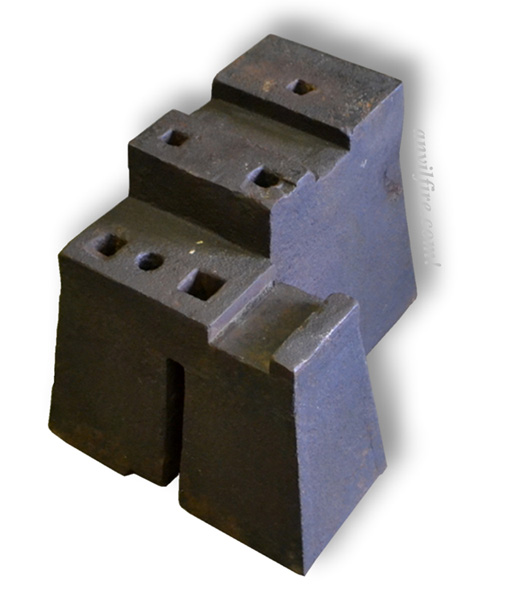Photos by Steve Prillwitz.
The unusual Cutler's (or filemakers') anvil is definitely a dedicated anvil having no common anvil features such as horn, heel or feet.
The slot between the main body and the side offset is a feature of unknown use.
The features of a cutlers' anvil are designed for nothing other than holding specialized tools in the slots and holes.
All the tooling is held in place by wedges. The wide notches for plates that act as "anvil" working surface, the holes for hardy type tools and more complcated top tools often mounted on pivots for repeditive work.
The anvil itself is nothing but the mass in this case. A few have vestigal parts of common anvils such as rounded horns.
This Cutler's anvil base measures 15 1/2" x 18 1/2" (394 x 470mm), the height of the tall section is 14 1/2" and 11 1/2" on the shorter section.
The top of the taller side is 8" x 11 1/2" and the top of the shorter side is 4 3/4" x 12 1/2".
Weight is 535 lb. (243 kg).





Photos by Steve Prillwitz.
The unusual Cutler's (or filemakers') anvil is definitely a dedicated anvil having no common anvil features such as horn, heel or feet. The slot between the main body and the side offset is a feature of unknown use.
The features of a cutlers' anvil are designed for nothing other than holding specialized tools in the slots and holes. All the tooling is held in place by wedges. The wide notches for plates that act as "anvil" working surface, the holes for hardy type tools and more complcated top tools often mounted on pivots for repeditive work. The anvil itself is nothing but the mass in this case. A few have vestigal parts of common anvils such as rounded horns.
This Cutler's anvil base measures 15 1/2" x 18 1/2" (394 x 470mm), the height of the tall section is 14 1/2" and 11 1/2" on the shorter section. The top of the taller side is 8" x 11 1/2" and the top of the shorter side is 4 3/4" x 12 1/2".
Weight is 535 lb. (243 kg).